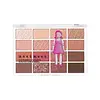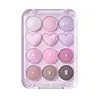What's inside
What's inside
 Key Ingredients
Key Ingredients

 Benefits
Benefits

 Concerns
Concerns

 Ingredients Side-by-side
Ingredients Side-by-side

Talc
AbrasiveMica
Cosmetic ColorantNylon-12
Octyldodecyl Stearoyl Stearate
EmollientPhenyl Trimethicone
Skin ConditioningMethylpropanediol
SolventTriethoxycaprylylsilane
Dipentaerythrityl Hexahydroxystearate/Hexastearate/Hexarosinate
Skin ConditioningDiisostearyl Malate
EmollientPropanediol
SolventCI 77492
Cosmetic ColorantCI 77891
Cosmetic ColorantHydrogenated Lecithin
EmulsifyingCI 75470
Cosmetic ColorantCI 77499
Cosmetic ColorantCI 77491
Cosmetic ColorantAluminum Hydroxide
EmollientMethicone
EmollientSilica
AbrasiveCalcium Aluminum Borosilicate
Neopentyl Glycol Diethylhexanoate
EmollientMagnesium Myristate
Dimethicone
EmollientIsostearyl Neopentanoate
EmollientMacadamia Ternifolia Seed Oil
EmollientPolybutene
Lauroyl Lysine
Skin ConditioningCI 77742
Cosmetic ColorantCI 19140
Cosmetic ColorantCalcium Titanium Borosilicate
AbrasiveMagnesium Stearate
Cosmetic ColorantTin Oxide
AbrasiveCI 77007
Cosmetic ColorantMaltodextrin
AbsorbentAluminum Starch Octenylsuccinate
AbsorbentKaolin
AbrasiveBoron Nitride
AbsorbentCI 77120
Cosmetic ColorantCaprylic/Capric Triglyceride
MaskingDimethiconol Stearate
EmollientSynthetic Fluorphlogopite
Ethylhexyl Palmitate
EmollientTriethylhexanoin
MaskingCalcium Sodium Borosilicate
Hydrogenated Castor Oil Isostearate
Skin ConditioningVinyl Dimethicone/Methicone Silsesquioxane Crosspolymer
Diphenylsiloxy Phenyl Trimethicone
Skin ConditioningBis-Behenyl/Isostearyl/Phytosteryl Dimer Dilinoleyl Dimer Dilinoleate
EmollientTalc, Mica, Nylon-12, Octyldodecyl Stearoyl Stearate, Phenyl Trimethicone, Methylpropanediol, Triethoxycaprylylsilane, Dipentaerythrityl Hexahydroxystearate/Hexastearate/Hexarosinate, Diisostearyl Malate, Propanediol, CI 77492, CI 77891, Hydrogenated Lecithin, CI 75470, CI 77499, CI 77491, Aluminum Hydroxide, Methicone, Silica, Calcium Aluminum Borosilicate, Neopentyl Glycol Diethylhexanoate, Magnesium Myristate, Dimethicone, Isostearyl Neopentanoate, Macadamia Ternifolia Seed Oil, Polybutene, Lauroyl Lysine, CI 77742, CI 19140, Calcium Titanium Borosilicate, Magnesium Stearate, Tin Oxide, CI 77007, Maltodextrin, Aluminum Starch Octenylsuccinate, Kaolin, Boron Nitride, CI 77120, Caprylic/Capric Triglyceride, Dimethiconol Stearate, Synthetic Fluorphlogopite, Ethylhexyl Palmitate, Triethylhexanoin, Calcium Sodium Borosilicate, Hydrogenated Castor Oil Isostearate, Vinyl Dimethicone/Methicone Silsesquioxane Crosspolymer, Diphenylsiloxy Phenyl Trimethicone, Bis-Behenyl/Isostearyl/Phytosteryl Dimer Dilinoleyl Dimer Dilinoleate
Calcium Titanium Borosilicate
AbrasiveTalc
AbrasiveDiisostearyl Malate
EmollientCaprylic/Capric Triglyceride
MaskingTitanium Dioxide
Cosmetic ColorantHydrogenated Castor Oil Isostearate
Skin ConditioningZinc Stearate
Cosmetic ColorantCalcium Sodium Borosilicate
Calcium Aluminum Borosilicate
Silica
AbrasiveMica
Cosmetic ColorantCaprylyl Glycol
EmollientTin Oxide
AbrasiveGlyceryl Caprylate
EmollientEthylhexylglycerin
Skin ConditioningCI 77491
Cosmetic ColorantStearic Acid
CleansingWater
Skin ConditioningCI 75470
Cosmetic ColorantTocopherol
AntioxidantSynthetic Fluorphlogopite
CI 77510
Cosmetic ColorantPolymethyl Methacrylate
Lauroyl Lysine
Skin ConditioningDimethicone
EmollientOctyldodecyl Stearoyl Stearate
EmollientIsocetyl Myristate
EmollientMagnesium Myristate
Aluminum Hydroxide
EmollientTriethoxycaprylylsilane
Hydrogenated Lecithin
EmulsifyingCI 77492
Cosmetic ColorantUltramarines
Kaolin
AbrasiveCI 77742
Cosmetic ColorantCI 77499
Cosmetic ColorantCalcium Titanium Borosilicate, Talc, Diisostearyl Malate, Caprylic/Capric Triglyceride, Titanium Dioxide, Hydrogenated Castor Oil Isostearate, Zinc Stearate, Calcium Sodium Borosilicate, Calcium Aluminum Borosilicate, Silica, Mica, Caprylyl Glycol, Tin Oxide, Glyceryl Caprylate, Ethylhexylglycerin, CI 77491, Stearic Acid, Water, CI 75470, Tocopherol, Synthetic Fluorphlogopite, CI 77510, Polymethyl Methacrylate, Lauroyl Lysine, Dimethicone, Octyldodecyl Stearoyl Stearate, Isocetyl Myristate, Magnesium Myristate, Aluminum Hydroxide, Triethoxycaprylylsilane, Hydrogenated Lecithin, CI 77492, Ultramarines, Kaolin, CI 77742, CI 77499
 Reviews
Reviews

Ingredients Explained
These ingredients are found in both products.
Ingredients higher up in an ingredient list are typically present in a larger amount.
Aluminum Hydroxide is a form of aluminum. It can be naturally found in nature as the mineral gibbsite. In cosmetics, Aluminum Hydroxide is used as a colorant, pH adjuster, and absorbent.
As a colorant, Aluminum Hydroxide may add opacity, or reduce the transparency. Aluminum hydroxide is contains both basic and acidic properties.
According to manufacturers, this ingredient is an emollient and humectant. This means it helps hydrate the skin.
In medicine, this ingredient is used to help relieve heartburn and help heal ulcers.
There is currently no credible scientific evidence linking aluminum hydroxide in cosmetics to increased cancer risk.
Major health organizations allow the use of aluminum hydroxide in personal care products and have not flagged it as a carcinogenic risk at typical usage levels.
Learn more about Aluminum HydroxideCalcium Aluminum Borosilicate is made up of calcium, aluminum, and silicates. It is a glass-like material. In cosmetics, it comes in the form of flakes or microspheres.
Calcium aluminum borosilicate is a bulking agent, meaning it helps thicken a product.
This ingredient is created by slowly mixing several minerals, including kaolin clay.
Although “aluminum” in an ingredient name can raise red flags for some consumers, the form and usage context matter significantly. For typical topical applications, there is no substantial evidence of health risks - such as cancer, neurotoxicity, or systemic “aluminum overload.”
Learn more about Calcium Aluminum BorosilicateCalcium Sodium Borosilicate is a bulking agent. It is considered a borosilicate glass; it is composed of powder or flakes of calcium and sodium borosilicates.
This ingredient is used to add volume, shine, and color to products. You'll most likely find this ingredient in makeup products.
According to in-vivo and ex-vivo studies done by a manufacturer, this ingredient works well with UV filters:
Learn more about Calcium Sodium BorosilicateCalcium Titanium Borosilicate is an exfoliant.
This ingredient is an emollient, solvent, and texture enhancer. It is considered a skin-softener by helping the skin prevent moisture loss.
It helps thicken a product's formula and makes it easier to spread by dissolving clumping compounds.
Caprylic Triglyceride is made by combining glycerin with coconut oil, forming a clear liquid.
While there is an assumption Caprylic Triglyceride can clog pores due to it being derived from coconut oil, there is no research supporting this.
Learn more about Caprylic/Capric TriglycerideCi 75470 is a bright-red pigment. It is AKA carmine.
Carmine is derived from insects such as the cochineal beetle. This ingredient has been used as a natural dye for over 2000 years.
Ci 77491 is also hydrated iron III oxide. It's sole purpose is to give a red/pink hue to products.
Iron III oxides are classified as inorganic chemicals for coloring.
Synthetically created Ci 77491 is considered safer than those naturally found. This is because the synthetically created version may contain less impurities. Iron oxides are generally non-toxic and non-allergenic.
Learn more about CI 77491Ci 77492 is also hydrated iron III oxide. It's sole purpose is to give a yellow hue to products.
Iron III oxides are classified as inorganic chemicals for coloring.
Synthetically created Ci 77492 is considered safer than those naturally found. This is because the synthetically created version may contain less impurities. Iron oxides are generally non-toxic and non-allergenic.
Learn more about CI 77492Ci 77499 is also hydrated iron III oxide. It is created from mixing red and black iron oxides. This helps give shades of darkness to a product.
Iron III oxides are classified as inorganic chemicals for coloring.
This ingredient is used to add a violet color to cosmetics.
It is created by reacting phosphoric acid, ammonium dihydrogen orthophosphate, and manganese dioxide.
Diisostearyl Malate is an emollient and most often used in lip products. It comes from isostearyl alcohol, a fatty acid, and malic acid, an AHA.
As an emollient, Diisostearyl Malate helps create a thin film on your skin to trap moisture in. This helps keep your skin soft and smooth.
Dimethicone is a type of synthetic silicone created from natural materials such as quartz.
What it does:
Dimethicone comes in different viscosities:
Depending on the viscosity, dimethicone has different properties.
Ingredients lists don't always show which type is used, so we recommend reaching out to the brand if you have questions about the viscosity.
This ingredient is unlikely to cause irritation because it does not get absorbed into skin. However, people with silicone allergies should be careful about using this ingredient.
Note: Dimethicone may contribute to pilling. This is because it is not oil or water soluble, so pilling may occur when layered with products. When mixed with heavy oils in a formula, the outcome is also quite greasy.
Learn more about DimethiconeHydrogenated Castor Oil Isostearate is an oil and isn't fungal acne safe.
Hydrogenated Lecithin is created from the hydrogenation of lecithin (a group of phospholipids). Hydrogenation is a chemical reaction between hydrogen and another element.
This ingredient is an emollient and emulsifier. As an emollient, it helps soften skin by trapping moisture within. As an emulsifier, it prevents oil and water ingredients from separating.
Kaolin is a clay. It is used for oil control and to help minimize pores. Like other clays, kaolin has the ability to absorb excess sebum or oil. This can help clean out pores and mattify the skin.
Some types of kaolin may have exfoliating properties. When water is added to kaolin, it becomes a paste with small abrasive particles.
Most kaolin is a white color, but may be pink/orange/red depending on where it comes from.
The name 'kaolin' comes from a Chinese village named 'Gaoling'. Kaolin clay comes from rocks rich in kaolinite. Kaolinite, the mineral, has a silicate layered structure. Kaolinite is formed from chemical weathering of aluminum siilicate minerals.
Besides skincare, kaolin is commonly used to make glossy paper, in ceramics, toothpaste, and as medicine to soothe stomach issues.
Learn more about KaolinThis ingredient comes from a fatty acid (lauric acid) and amino acid (lysine). It is used to add a silky feel to cosmetics.
According to a manufacturer, its fatty acid base leaves a silky feeling on the skin. It also has emollient properties because of this. Emollients help soften skin by preventing water from evaporating.
Lauroyl lysine is barely soluble in water.
Learn more about Lauroyl LysineWe don't have a description for Magnesium Myristate yet.
Mica is a naturally occurring mineral used to add shimmer and color in cosmetics. It can also help improve the texture of a product or give it an opaque, white/silver color.
Serecite is the name for very fine but ragged grains of mica.
This ingredient is often coated with metal oxides like titanium dioxide. Trace amounts of heavy metals may be found in mica, but these metals are not harmful in our personal products.
Mica has been used since prehistoric times throughout the world. Ancient Egyptian, Indian, Greek, Roman, Aztec, and Chinese civilizations have used mica.
Learn more about MicaOctyldodecyl Stearoyl Stearate is created from stearic acid.
It is an emollient and thickens the lipid (oil) portion of a product. Due to its emollient properties, it may not be fungal-acne safe.
Silica, also known as silicon dioxide, is a naturally occurring mineral. It is used as a fine, spherical, and porous powder in cosmetics.
Though it has exfoliant properties, the function of silica varies depending on the product.
The unique structure of silica enhances the spreadability and adds smoothness, making it a great texture enhancer.
It is also used as an active carrier, emulsifier, and mattifier due to its ability to absorb excess oil.
In some products, tiny microneedles called spicules are made from silica or hydrolyzed sponge. When you rub them in, they lightly polish away dead skin layers and enhance the penetration of active ingredients.
Learn more about SilicaSynthetic Fluorphlogopite is the synthethic version of mica. It consists of fluorine, aluminum and silicate.
Synthetic Fluorphlogopite is used to add volume to products.
It is considered non-irritating on the skin.
Learn more about Synthetic FluorphlogopiteTalc is a clay mineral. It helps absorb moisture and improve the texture of products. Like other types of clay, Talc can have a slight exfoliating effect on skin. Talc can be added to increase the volume of products.
Some Baby powders are made by combining talc with corn starch. The word "talc" comes from Latin and originates from Arabic. Talc is a mineral commonly found throughout the world.
If you have any concerns about using talc, we recommend checking out the FDA's official page.
Learn more about TalcTin Oxide is an inorganic oxide used to add opacity and volume to a product. In nature, it is already found in mineral form. The main ore of tin is an opaque and shiny mineral called casseterite.
Tin Oxide helps remove translucency in a product, or make it more opaque. Besides adding opacity, tin oxide is used for bulking to add volume.
Triethoxycaprylylsilane is a silicone used to bind and stabilize ingredients.
As an emulsifier, it helps prevent ingredients from separating. This can help elongate the shelf life of products.
Triethoxycaprylylsilane is often used to coat mineral sunscreens ingredients to help give a better feel. It also helps reduce oxidative stress in sunscreens.
Learn more about Triethoxycaprylylsilane